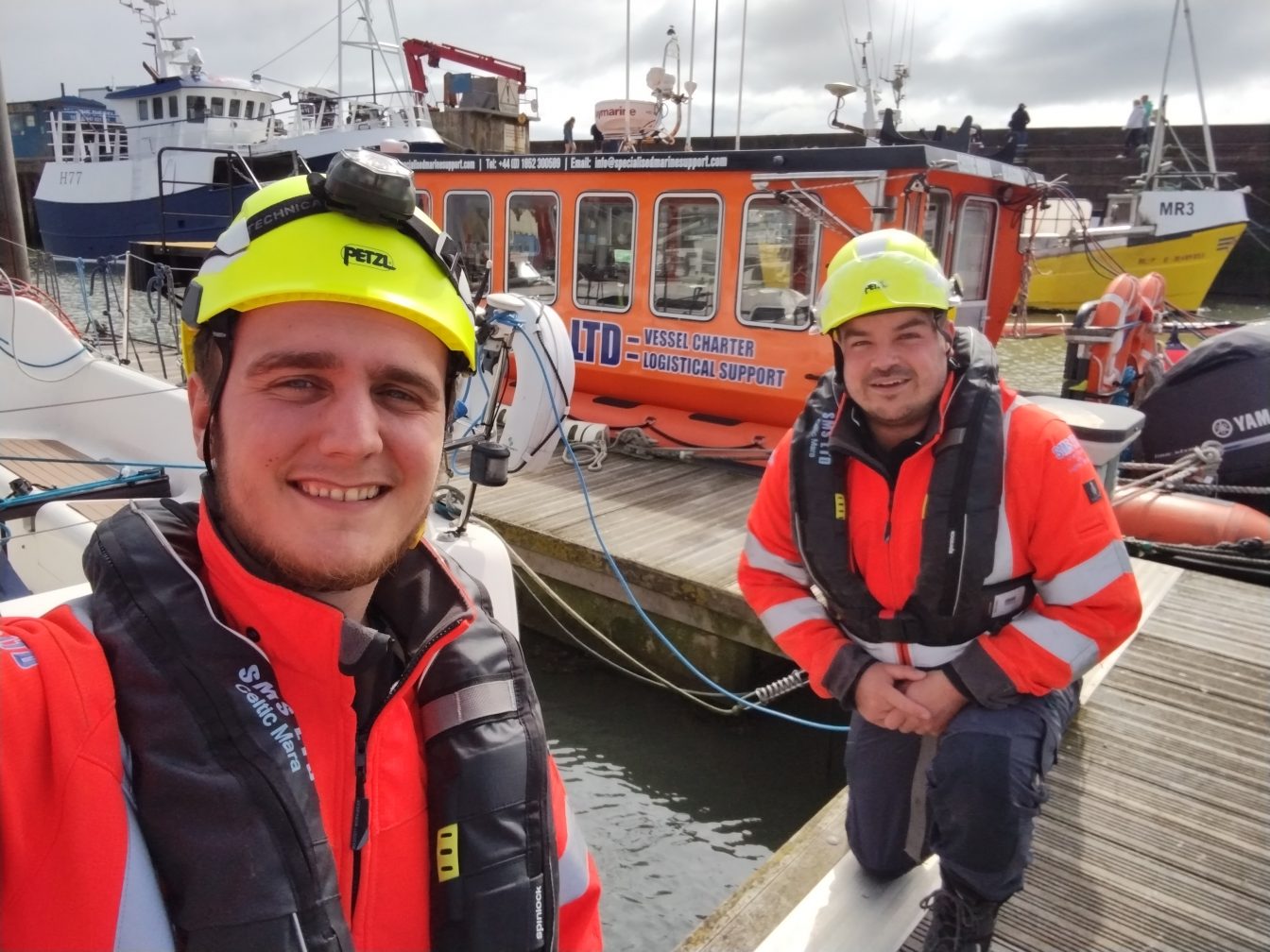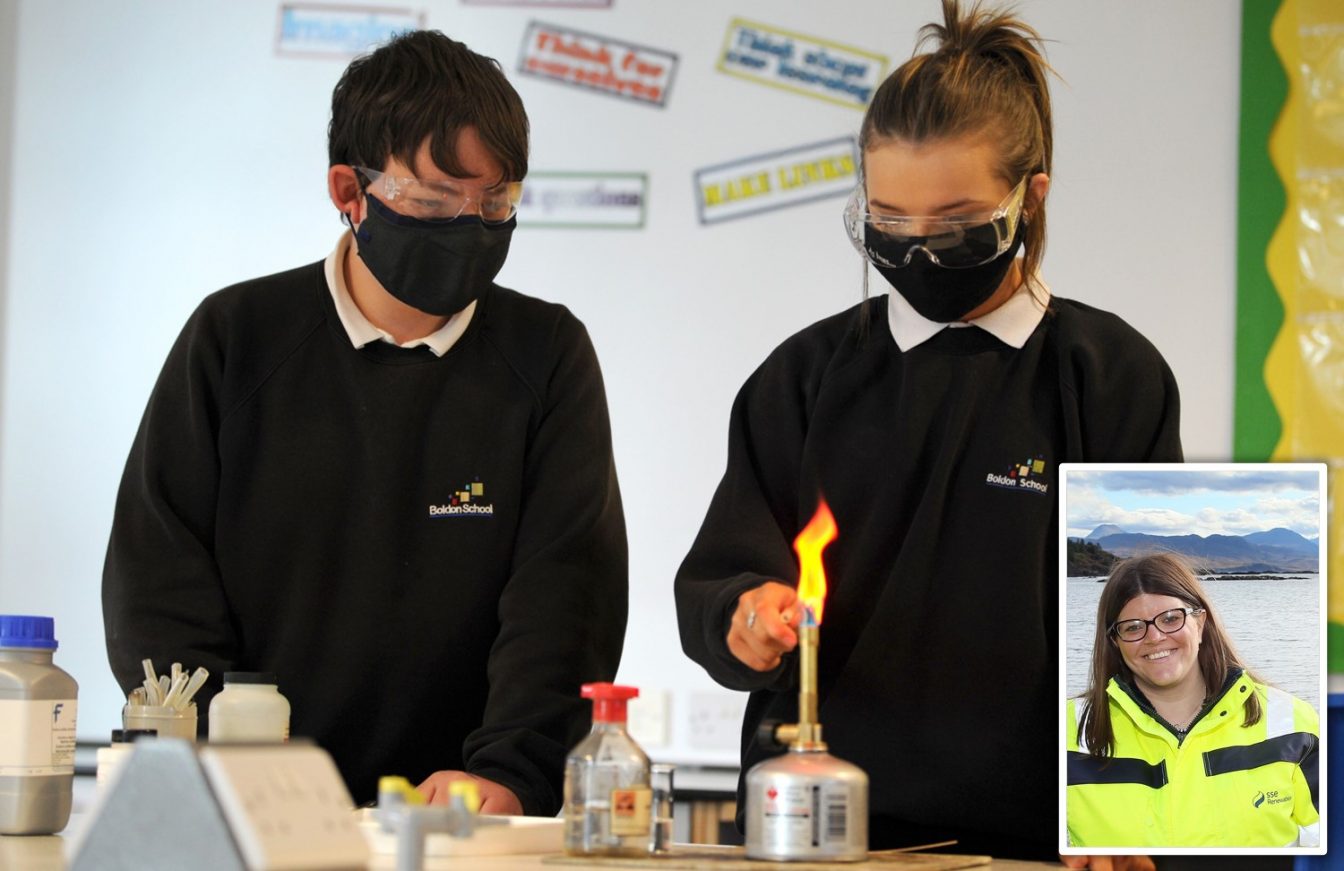31st August 2021 in Community News, Press releases, Project news

A marine support crew working on Dogger Bank Wind Farm rescued a young boy at the weekend, when he got into difficulty in water at Bridlington Harbour.
The two-man crew from Scotland-based SMS was returning to the harbour on Sunday, when they heard a splash on the opposite side of the pontoon.
Celtic Mara Skipper Chris Warren and Deck Hand Neil MacInnes, spotted a young boy clinging to side of the pontoon in a state of panic. Neil pulled the boy to safety while Chris prevented a ladder from a nearby yacht falling onto the boy’s head.
The team offered the little boy, aged approximately 7 or 8, thermal protection and reassurance before leaving him in the care of his family.
“We were happy to have been in the right place at the right time to reach out and help this little boy. When we got to him he was shocked, cold and shivery, but thankfully didn’t appear to have swallowed any water,” explained Chris.
“We didn’t see how he got into difficulty and while the water there isn’t that deep, the ground is thick with mud and the temperature of the water is enough to send you into a panic.
“As we’re all trained in health and safety, first-aid and marine rescue, having commercial boats in a harbour to support a wind farm development can offer an extra degree of resilience, in addition to the critical work already carried out by the local RNLI and independent lifeboat crews.
“In our work we come across quite a lot of people near water who aren’t wearing lifejackets, and perhaps don’t fully appreciate the hidden dangers of falling into cold water.
“ As experienced mariners we would advise anyone who is spending time near water to follow the advice given by the RNLI at www.rnli.org”
Dogger Bank Wind Farm, which is to be built more than 130km off the Yorkshire coast in the North Sea, is currently being developed in three 1.2GW phases: Dogger Bank A, B and C.
Dogger Bank A and B is a joint venture between SSE Renewables (40 per cent), Equinor (40 per cent) and Eni (20 per cent), and will connect the National Grid between Beverley and Cottingham. Dogger Bank C is a 50:50 joint venture between SSE Renewables and Equinor and will connect the National Grid on Teesside.
Chris and Neil are currently supporting Dogger Bank’s export cable provider, NKT and its sub-contractor ABCO, with crew transfers as they carry out inspection work on the nearshore cable route for A and B, adjacent to the landfall point at Ulrome.
Community Engagement Manager for Dogger Bank Wind Farm, Rachel Lawrence, said:
“The crew’s quick actions undoubtedly prevented what could have turned out to be a very different day for the little boy.
“The safety of people working on our development and the surrounding communities is paramount on Dogger Bank Wind Farm. The Celtic Mara team perfectly embody that safety culture, and deserve to be recognised for demonstrating how to work swiftly, calmly and efficiently in a crisis.
“We hope the little boy involved is feeling much better. ”
23rd August 2021 in Blogs, Community News, Project news

“With the risk of employment uncertainty in the post-pandemic world, and with many of our young people impacted by education and social challenges, we have an opportunity to use our net zero future as a springboard to turn this tide,” explains Lindsay Dougan, Community Investment Manager on Dogger Bank Wind Farm.
“Dogger Bank Wind Farm is a key asset for the north and north-east of England. It will create and support thousands of jobs, as well as ensuring clean energy for future generations with the capacity to power 6 million UK homes. We take seriously our responsibility to develop the wind farm sustainably and part of this is our social commitment to share the benefit with coastal communities. We will invest £1 million during the construction of the wind farm and have committed to focusing on enhancing STEM (science, technology, engineering and maths) attainment to ensure young people are prepared for the jobs of the future.
“We made a commitment when we were developing the wind farm that we would invest in STEM as we have a responsibility to make sure young people are ready for the job opportunities on their doorstep. What we didn’t foresee was that we would be delivering this commitment during a pandemic!
“Young people have had to experience social isolation and virtual learning in the last 18 months and we have an opportunity to use our net zero future to help them thrive during the pandemic recovery and beyond.
“We have taken our commitment to local areas seriously – we have listened to education and skills partners and it is their expertise and local priorities which has determined what the STEM funding focuses on from early years in East Riding of Yorkshire to school transition in South Tyneside. This approach ensures it maximises its impact for the 25,000 young people in these local areas.
“Our net zero future promises roles that will be challenging and rewarding in equal measure. From the turbine technicians who ensure the wind farms achieve optimum performance to the planning experts who will bring us even larger and more innovative wind farms in the future. The energy transition is one of society’s most pressing priorities and we have a responsibility to inspire and support the experts who will be the key to its success.
“We know from our experience engaging with local schools how keen young people are to challenge themselves to live sustainable lives. In a recent visit to Skipsea Primary School in East Riding a colleague was asked by an 8-year-old boy whether she bought her electricity from renewable energy sources. The smart boy cleverly pointed out the electric vehicle she arrived in would only help the planet if she was buying her fuel from sustainable providers. We may be the trailblazers of offshore wind but it’s the eight-year-olds of today who will shape our tomorrow.
“As we continue to build the world’s largest offshore wind farm at Dogger Bank, we have a one-in-a-lifetime opportunity to improve the lives of people living in the coastal communities where we’re installing our infrastructure. And there’s never been a more important time to get this right.”
23rd August 2021 in Community News, Press releases, Project news

Beeford Bowling Club has become the first community group to receive a financial award from Dogger Bank Wind Farm’s new operators fund.
The £500 award will enable the group to lay a concrete base for its new equipment storage shed, as it supports members of the community to become more active following months in lockdown.
Dogger Bank Wind Farm launched its £1 million construction fund in June. The programme will enable all 124 primary schools in East Riding of Yorkshire and all 18 secondary schools in South Tyneside to increase and expand their science, technology, engineering and maths provision. Meanwhile, local community groups can apply for grants up to £500 to at https://doggerbank.com/about/community/
Work started on the onshore infrastructure for the first two phases of Dogger Bank Wind Farm last year. These phases will meet landfall at Ulrome in East Riding of Yorkshire, and connect to the National Grid between Beverley and Cottingham. The third phase of the wind farm will meet landfall at Redcar on Teesside, connecting to the National Grid at Lackenby.
Rachel Lawrence, Community Engagement Manager for Dogger Bank Wind Farm, said:
“Social isolation and lack of physical activity have both been major issues for vulnerable groups in our communities during the lockdown period. We’re delighted our first award will support a group offering a lifeline to Beeford residents, helping them to reintegrate into their community while being physically active. Despite their best efforts, the group has struggled to raise vital funds due to COVID restrictions. We couldn’t be happier to step in and support this community that has welcomed and supported us as we build the onshore infrastructure for the first two phases of the world’s largest offshore wind farm in East Riding of Yorkshire.”
Beeford Bowling Club Chairman, Cliff Hollingsworth, said:
“The past two seasons have been hard for the club as we have not been able to have fundraising events to allow us to improve our facilities. Any grants to help us do this are more than welcome and this £500 from Dogger Bank Wind Farm has come at the right time to allow us to get the base done for our new shed which means we can now follow through with this before the winter. So many thanks again from Beeford Bowling Club.”
Dogger Bank wind farm is being built in three phases, Dogger Bank A, B and C. Dogger Bank A and B are a joint venture between SSE Renewables (40%), Equinor (40%) and Eni (20%). Dogger Bank C is a joint venture between SSE Renewables (50%) and Equinor (50%). SSE renewables is leading on the construction of the wind farm and Equinor will operate the wind farm for its lifetime of up to 35 years.
28th July 2021 in Blogs, Press releases, Project news

As a graduate engineer working on the world’s largest offshore wind farm Grant Beaton is not only developing his professional expertise, but he’s also feeding his desire to play a critical role in the global energy transition.
The 24-year-old University of Strathclyde graduate shares an insight into his role on Dogger Bank Wind Farm, offers advice to industry hopefuls and talks about why a trainee engineer should never stop asking questions.
“After leaving school I went to study a Masters in Electrical and Mechanical Engineering at the University of Strathclyde. Doing a joint degree was challenging but definitely worthwhile, and I’m keen to develop my knowledge of both fields as I progress in my role on Dogger Bank Wind Farm as a graduate engineer.
“The renewable energy industry is constantly growing and is a sector that will continue to innovate as we meet the demands of the net zero journey, so I was thrilled to be able to join the Dogger Bank team in September 2020.
“I’ve always had a keen interest in the pursuit of solutions to some of the world’s biggest problems, and that’s pretty much what drove my desire to become an engineer. Even from the start of my studies until now there has been a real shift in the momentum of people wanting their energy to be produced in a more sustainable way, and it’s exciting to be part of that change.
“It’s been incredible to be working on a project the size of Dogger Bank and to be able to say you’ve contributed to it, but I can’t deny it’s also been a real learning curve. The hard work and ingenuity that goes on across the team on a daily basis is inspiring. As a young professional just starting out on a career path it’s been invaluable to understand the challenges and strengths required to make a project like this a success. That’s something that will stick with me for the rest of my career and will undoubtedly shape the engineer I’ll become.
“My long-term goals are to help the industry to achieve the net zero vision. On a short-term personal level I’m pretty open-minded about where my career will take me and what I’d like to do after finishing the graduate scheme. Throughout the two years I want to gain as much experience as possible, in as many business areas and teams as I can, and I’m obviously spoilt for choice when it comes to working on the world’s largest offshore wind farm.
“I’ve got a brilliant opportunity to work in roles I’ve had little or no knowledge about previously and I feel that will only be beneficial to my future career. I want to understand as much as possible about how the different teams and departments work together to bring projects like Dogger Bank through to completion.
“I have no regrets about the career choices I’ve made and would advise green-energy hopefuls to be open-minded about where they might fit into the renewable industry. Even if there is something you’re currently really passionate about, I’ve learnt that giving the time to different areas is beneficial to increase your knowledge, experience and overall confidence. I also think the best thing a young engineer can do is to keep asking questions, no matter how simple or complex they may be. Asking a question and getting an explanation that finally makes something click can take all of 2 minutes, but will make all the difference to the contribution you can make to a project like Dogger Bank.
“It’s hard to go half a day these days without hearing another story illustrating the severity of the climate crisis we find ourselves in. With the capacity to provide renewable energy for 6 million UK homes, Dogger Bank Wind Farm is demonstrating what can be achieved when you build on this scale using some of the world’s best available technology.
“I’ve got a real opportunity to contribute to this world-leading project and shape the future of green energy. I can’t think of another graduate opportunity that holds more promise for a young engineer.”
Grant Beaton, Graduate Engineer, Dogger Bank Wind Farm
23rd July 2021 in Press releases, Project news, Supply Chain, Uncategorised

South Tyneside manufacturer Metec UK has won two multi-million pound contracts on Dogger Bank Wind Farm.
Metec UK manufactures sacrificial anodes for the long-term protection of steel jackets and foundations against corrosion, and is used in the offshore renewable energy industry.
The fast-growing company, established only four years ago, will supply cathodic protection sacrificial anodes for transition pieces and monopiles, for the first two phases of the record-breaking wind farm.
Built by SSE Renewables and operated by Equinor, the wind farm has already created or supported thousands of new jobs and will be built in three phases, Dogger Bank A, B and C.
Alberto Via, UK Managing Director of METEC UK, said:
“Over the last six months we’ve been absolutely delighted to win a number of domestic and international contracts, including in Scotland, France and Holland. These latest successes – and in particular the flagship Dogger Bank Wind Farm contract – justifies our commitment to South Tyneside, the north-east and the UK. Our success demonstrates our ability to support large, important and prestigious renewable energy projects of this nature throughout the UK and Europe.
“We have the capacity, capability and expertise at Metec that places us right at the heart of where we need to be in an industry which is set to see significant growth and investment over the next 10 years.
“As a young, ambitious and expanding company, which has invested over £4 million in premises and furnaces since 2017, we expect to see further growth throughout 2021. We are in this for the long term and we’re very excited for the future of Metec and the industry as a whole.”
Metec UK, which has manufacturing facilities in South Shields and Tunisia with representation around the globe, is a leading manufacturer of corrosion protection for high value subsea assets. Initially employing just six people, the company now has 45 people within its business.
Halfdan Brustad, Vice President for Dogger Bank at Equinor, said:
“As we build up our operations in South Tyneside it’s great to see a local company not only win this flagship contract with the world’s biggest offshore wind farm, but also exporting to other countries.
“With ambitious targets to quadruple UK capacity in the next decade, the offshore wind industry provides billions of pounds of supply chain opportunities, and in supporting UK companies we will also build up a competitive supply chain that can win international contracts.
“We look forward to continuing to work with UK companies, particularly in northern England where we will operate the wind farm for decades to come.”
Metec UK is a sub-contractor with Dogger Bank Wind Farm’s tier one contractor, Smulders. Smulders was selected for the supply, fabrication and fit-out of the secondary steel for the transition pieces in late 2020. Smulders will work alongside Sif, the company selected to provide fabrication and supply of 190 monopiles and primary steel for the transition pieces.





